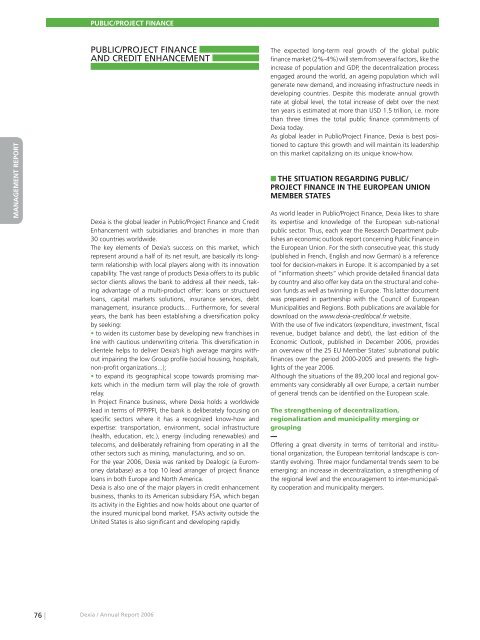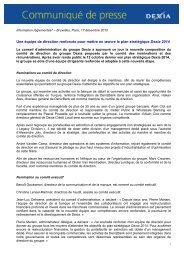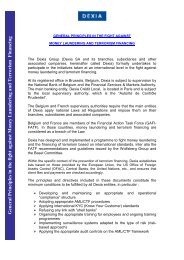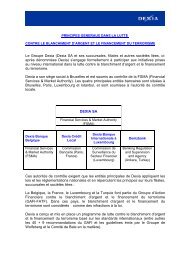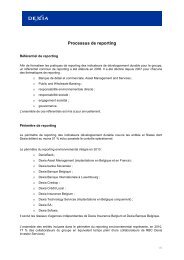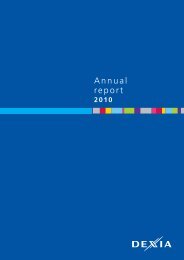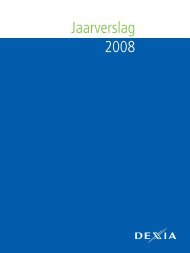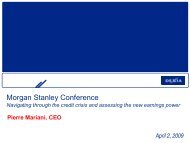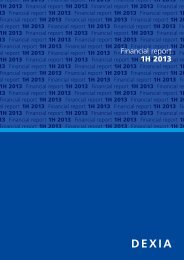Annual report 2006 - Dexia.com
Annual report 2006 - Dexia.com
Annual report 2006 - Dexia.com
You also want an ePaper? Increase the reach of your titles
YUMPU automatically turns print PDFs into web optimized ePapers that Google loves.
PUBLIC/PROJECT FINANCE<br />
MANAGEMENT REPORT<br />
COMPTES CONSOLIDÉS<br />
COMPTES SOCIAUX<br />
PUBLIC/PROJECT FINANCE<br />
AND CREDIT ENHANCEMENT<br />
<strong>Dexia</strong> is the global leader in Public/Project Finance and Credit<br />
Enhancement with subsidiaries and branches in more than<br />
30 countries worldwide.<br />
The key elements of <strong>Dexia</strong>’s success on this market, which<br />
represent around a half of its net result, are basically its longterm<br />
relationship with local players along with its innovation<br />
capability. The vast range of products <strong>Dexia</strong> offers to its public<br />
sector clients allows the bank to address all their needs, taking<br />
advantage of a multi-product offer: loans or structured<br />
loans, capital markets solutions, insurance services, debt<br />
management, insurance products... Furthermore, for several<br />
years, the bank has been establishing a diversification policy<br />
by seeking:<br />
• to widen its customer base by developing new franchises in<br />
line with cautious underwriting criteria. This diversification in<br />
clientele helps to deliver <strong>Dexia</strong>’s high average margins without<br />
impairing the low Group profile (social housing, hospitals,<br />
non-profit organizations...);<br />
• to expand its geographical scope towards promising markets<br />
which in the medium term will play the role of growth<br />
relay.<br />
In Project Finance business, where <strong>Dexia</strong> holds a worldwide<br />
lead in terms of PPP/PFI, the bank is deliberately focusing on<br />
specific sectors where it has a recognized know-how and<br />
expertise: transportation, environment, social infrastructure<br />
(health, education, etc.), energy (including renewables) and<br />
tele<strong>com</strong>s, and deliberately refraining from operating in all the<br />
other sectors such as mining, manufacturing, and so on.<br />
For the year <strong>2006</strong>, <strong>Dexia</strong> was ranked by Dealogic (a Euromoney<br />
database) as a top 10 lead arranger of project finance<br />
loans in both Europe and North America.<br />
<strong>Dexia</strong> is also one of the major players in credit enhancement<br />
business, thanks to its American subsidiary FSA, which began<br />
its activity in the Eighties and now holds about one quarter of<br />
the insured municipal bond market. FSA’s activity outside the<br />
United States is also significant and developing rapidly.<br />
The expected long-term real growth of the global public<br />
finance market (2%-4%) will stem from several factors, like the<br />
increase of population and GDP, the decentralization process<br />
engaged around the world, an ageing population which will<br />
generate new demand, and increasing infrastructure needs in<br />
developing countries. Despite this moderate annual growth<br />
rate at global level, the total increase of debt over the next<br />
ten years is estimated at more than USD 1.5 trillion, i.e. more<br />
than three times the total public finance <strong>com</strong>mitments of<br />
<strong>Dexia</strong> today.<br />
As global leader in Public/Project Finance, <strong>Dexia</strong> is best positioned<br />
to capture this growth and will maintain its leadership<br />
on this market capitalizing on its unique know-how.<br />
THE SITUATION REGARDING PUBLIC/<br />
PROJECT FINANCE IN THE EUROPEAN UNION<br />
MEMBER STATES<br />
As world leader in Public/Project Finance, <strong>Dexia</strong> likes to share<br />
its expertise and knowledge of the European sub-national<br />
public sector. Thus, each year the Research Department publishes<br />
an economic outlook <strong>report</strong> concerning Public Finance in<br />
the European Union. For the sixth consecutive year, this study<br />
(published in French, English and now German) is a reference<br />
tool for decision-makers in Europe. It is ac<strong>com</strong>panied by a set<br />
of “information sheets” which provide detailed financial data<br />
by country and also offer key data on the structural and cohesion<br />
funds as well as twinning in Europe. This latter document<br />
was prepared in partnership with the Council of European<br />
Municipalities and Regions. Both publications are available for<br />
download on the www.dexia-creditlocal.fr website.<br />
With the use of five indicators (expenditure, investment, fiscal<br />
revenue, budget balance and debt), the last edition of the<br />
Economic Outlook, published in December <strong>2006</strong>, provides<br />
an overview of the 25 EU Member States’ subnational public<br />
finances over the period 2000-2005 and presents the highlights<br />
of the year <strong>2006</strong>.<br />
Although the situations of the 89,200 local and regional governments<br />
vary considerably all over Europe, a certain number<br />
of general trends can be identified on the European scale.<br />
The strengthening of decentralization,<br />
regionalization and municipality merging or<br />
grouping<br />
Offering a great diversity in terms of territorial and institutional<br />
organization, the European territorial landscape is constantly<br />
evolving. Three major fundamental trends seem to be<br />
emerging: an increase in decentralization, a strengthening of<br />
the regional level and the encouragement to inter-municipality<br />
cooperation and municipality mergers.<br />
76 |<br />
<strong>Dexia</strong> / <strong>Annual</strong> Report <strong>2006</strong>


